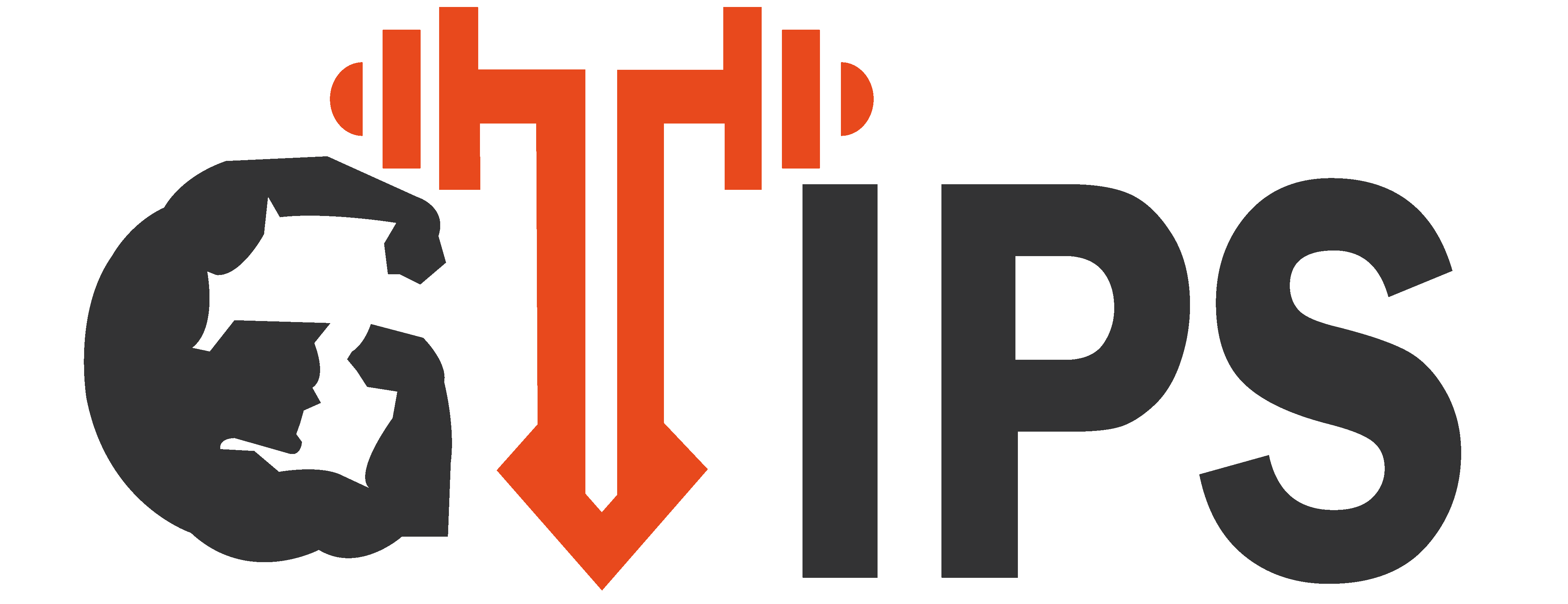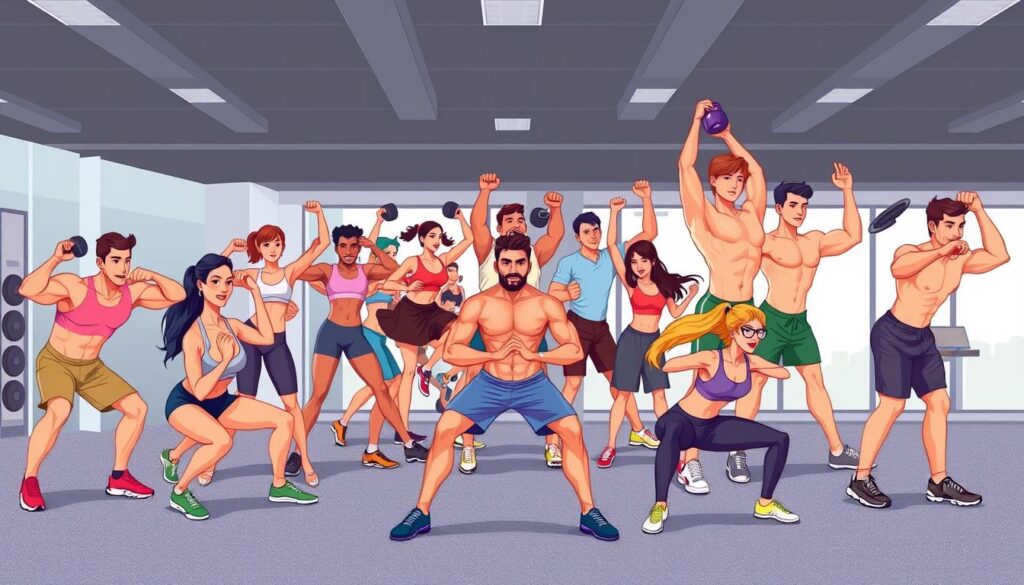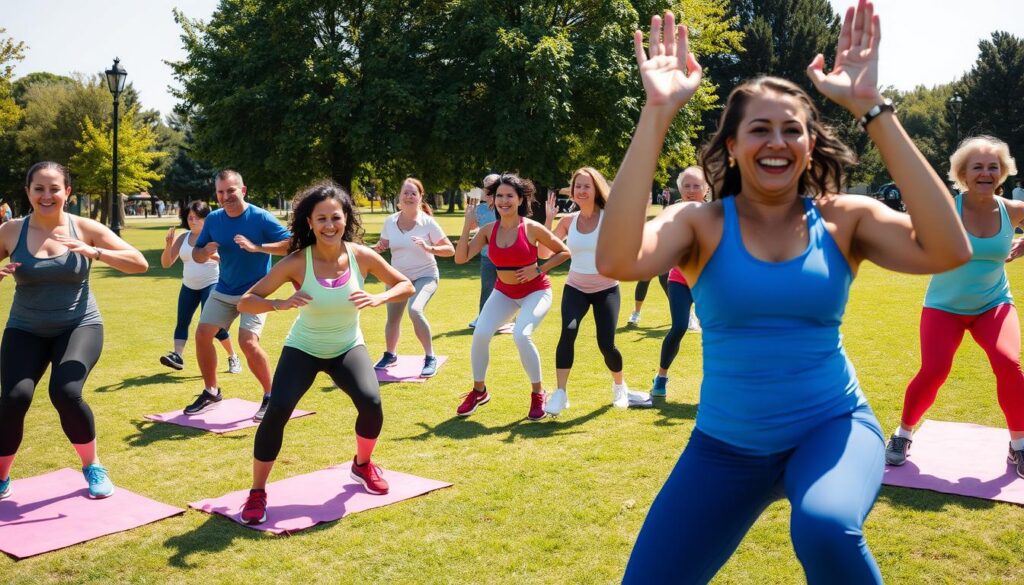Are you tired of spending hours in the gym without seeing results? It’s time to try full-body workout routines. These routines work on many muscle groups at once, making your workouts more efficient. Whether you’re new to fitness or have been working out for years, the 10 best full-body workout routines in this article can help you reach your goals.
Full-body workouts use compound movements that work many muscles at once. Exercises like squats, deadlifts, rows, and presses help build strength all over your body. They also improve your athletic skills and help you reach your full fitness level. By working out your whole body in one session, you can do fewer workouts each week. This makes it easier to fit exercise into your busy life.
But which full-body workout is best for you? In this guide, we’ll look at many options for different fitness levels. Get ready to learn how to do full-body workouts that will change your body and improve your performance.
Key Takeaways
- Full-body workouts target multiple muscle groups in a single session, promoting efficiency and overall fitness.
- These routines focus on compound movements that engage multiple muscle groups, building total-body strength and improving athletic performance.
- Full-body workouts can be performed 3 times a week, allowing for adequate recovery between sessions.
- The 10 best full-body workout routines outlined in this article cater to various fitness levels, from beginner to advanced.
- Incorporating full-body training into your fitness regimen can help you achieve your goals more effectively and efficiently.
Understanding Full-body Workout Fundamentals
Learning the basics of full-body workouts is key to reaching your fitness goals. These routines include six main movements: squat, hinge, lunge, push, pull, and carry. By focusing on these, you build strong muscles, boost your mobility, and reach your fitness targets faster.
Movement Patterns in Full-body Training
The squat works your lower body, core, and stabilizers. The hinge focuses on your glutes and hamstrings. Lunges improve balance and strength in your lower body. Push and pull exercises strengthen your upper body. Carrying exercises, like farmer’s walks, boost grip and core stability.
Role of Compound Exercises
Compound exercises are vital in full-body workouts. They work many muscles at once. Squats, deadlifts, and bench presses are examples. They help you grow muscles faster than single-muscle exercises.
Training Frequency and Recovery
For full-body workouts, training 3 times a week is best. This gives your muscles 48 hours to recover. Finding the right balance between working out and resting is essential for progress and avoiding injuries.
“Full-body workout routines are a time-efficient and effective way to build strength, improve overall fitness, and achieve your fitness goals.” – Certified Personal Trainer, [Name]
Benefits of Regular Full-body Training
Adding full-body workouts to your routine offers many benefits. These workouts target many muscle groups at once. This helps in building muscle and burning fat efficiently. They also boost your heart health and save time during workouts.
Full-body training boosts your muscle strength, endurance, and balance. It works out different muscles, making your fitness more balanced and useful. It also raises your heart rate, which is good for your heart and lowers disease risks.
One big plus of full-body workouts is how quickly they save time. They work out many muscles in one go. This is perfect for people with busy lives who want to get fit fast.
- Improved muscular strength, endurance, and balance
- Enhanced cardiovascular health and aerobic capacity
- Time-efficient training that targets multiple muscle groups
- Balanced and functional fitness development
- Reduced risk of muscle imbalances and overtraining
Doing full-body workouts regularly can make muscles stronger and more enduring in just 30 days. By mixing up compound exercises, you can grow muscles and stay fit all over.
“Full-body workouts are a game-changer for those seeking efficient and comprehensive fitness gains. The combination of targeted muscle-building and enhanced cardiovascular health makes this training style a must-try for individuals of all fitness levels.”
Essential Full-body Workout Routines for Beginners
Starting your fitness journey? Beginner-friendly full-body workouts are a great choice. They focus on basic movements. This helps you build a strong foundation of strength and technique.
Basic Movement Exercises
Here are some key exercises for beginners:
- Lunges: Work your lower body and core.
- Pushups: Challenge your upper body and chest.
- Squats: Strengthen your legs and glutes.
- Planks: Engage your core and improve stability.
Form and Technique Tips
Proper form is key to avoid injury and get the most out of your workout. Spend time learning the basics. If needed, get help from a certified trainer.
Progressive Overload Principles
As you get better, increase the challenge with progressive overload. This means adding more weight, reps, or sets. It helps your muscles grow stronger.
By doing these beginner workouts, you’ll boost your strength and fitness. You’ll also set the stage for more advanced training later on.
Advanced Full-body Workout Plans
As you get better in fitness, trying advanced full-body workout plans can really help. These plans use complex exercises like barbell squats, deadlifts, bench presses, and overhead presses. They push your body to grow and adapt.
These routines focus on getting stronger by adding more weight or reps over time. They also use periodization, which means changing your workout to keep your body challenged and adapting.
The aim is to grow your muscles and get stronger while keeping your body in top shape. These workouts are designed to test your limits and help you improve in strength training.
- Do compound exercises that work many muscles at once, like squats, deadlifts, and overhead presses, to build advanced exercises.
- Slowly increase the weight, reps, or intensity to keep growing your muscles and making progress.
- Try periodization, changing your workout phases to keep your body adapting and growing.
- Make sure to rest and recover well between workouts to help your muscles heal and grow.
- Keep track of how you’re doing and adjust your workout plan as needed.
Remember, advanced full-body workouts need a lot of commitment, proper form, and careful planning. They should challenge you without risking injury. Talk to a fitness expert to create a plan that fits your goals and abilities.
Bodyweight Full-body Workout Variations
Discover the strength of bodyweight exercises for a full-body workout that needs no equipment. These exercises are perfect for home workouts and can be adjusted to fit your fitness level.
Equipment-Free Exercises
Try different bodyweight movements like push-ups, squats, lunges, planks, and burpees. These exercises work many muscles at once, giving you a balanced workout. It’s important to learn the right form to stay safe and get the most out of each move.
Home Workout Adaptations
Turn your home into a workout area by using common items for extra resistance. Use a chair for elevated push-ups or dips, or a backpack filled with books for weighted squats and lunges. Be creative with what you have to enhance your workout.
Scaling Options for Different Fitness Levels
Bodyweight exercises can be adjusted for any fitness level. You can do more reps, add plyometric moves for more intensity, or change the speed to challenge yourself. The goal is to push yourself but keep your form right.
Adding these bodyweight workout variations to your routine offers a complete, equipment-free program. It adapts to your fitness goals and abilities. Embrace the flexibility of bodyweight exercises to stay active and reach your fitness dreams, no matter your skill level.
Strength Training with Full-body Workout Routines
Full-body strength training routines are great for building strength and muscle. These workouts use big exercises like squats, deadlifts, and bench presses. They work many muscles at once, focusing on strength building.
Getting stronger means using more weight and doing fewer reps. This is different from routines that focus on growing muscles.
Progressive overload is essential for getting stronger. It means adding more weight or reps over time. This keeps your muscles challenged and helps them grow.
| Exercise | Reps |
|---|---|
| Dumbbell Romanian Deadlift | 12 |
| Side-Plank Press | 12 per side |
| Glute Bridge Floor Press | 12 |
| Bulgarian Split Squat | 12 per side |
| Hollow Body Hold | 3-5 reps of 30 sec |
Full-body resistance training is good for those with little time or general fitness goals. It’s great for beginners, focusing on basic movements. But, it might not target specific muscles as well as other routines.
Rest is key after full-body workouts. Your muscles need time to grow stronger. Light cardio or mobility work on rest days helps your body recover.
High-Intensity Full-body Circuit Training
Discover the power of HIIT (High-Intensity Interval Training) with full-body circuit workouts. This method combines strength exercises with intense cardio bursts. It burns calories efficiently in a short time.
Circuit Structure and Timing
Full-body circuit routines include 6-10 exercises done one after another with little rest. Work intervals last 30-60 seconds, followed by 15-30 seconds of rest. This keeps your heart rate up and challenges your muscles.
Rest and Work Intervals
Finding the right balance between work and rest is key in high-intensity circuit training. Work periods should challenge you, while rest phases let your body catch its breath. Proper interval management helps maintain form and avoid fatigue.
Intensity Management
Mastering intensity levels in a full-body HIIT circuit is an art. You need to push yourself hard but not too hard to avoid injury. Learning to manage your effort ensures you get the most from the workout while staying safe.
“HIIT workouts are a game-changer for those seeking efficient, full-body conditioning. The combination of intense bursts and active recovery keeps your metabolism revved up long after the workout is over.”
Recovery and Nutrition for Full-body Workouts
Proper recovery and nutrition are key to getting the most from your full-body workouts. After a tough session, your muscles need time and the right food to heal and get stronger. Focusing on recovery and nutrition helps repair muscles, replenish energy, and get ready for the next workout.
To help with recovery, do full-body workouts up to four times a week. Make sure to rest for 3 minutes between sets. Also, have at least one rest day a week to let your muscles recover and grow. On days off, do light activities like walking or stretching to stay active without overdoing it.
Your post-workout meal should have protein, carbs, and healthy fats for muscle repair and hydration. Eat a meal or shake within 30 minutes of your workout. Focus on lean proteins like chicken, fish, or Greek yogurt, and complex carbs like whole grains or sweet potatoes.
| Nutrient | Importance | Food Sources |
|---|---|---|
| Protein | Supports muscle repair and growth | Lean meats, poultry, fish, eggs, dairy, legumes |
| Carbohydrates | Replenishes energy stores | Whole grains, fruits, vegetables, starchy foods |
| Healthy Fats | Provides energy and supports hormone production | Avocados, nuts, seeds, olive oil, fatty fish |
Drinking water before, during, and after workouts is vital for muscle recovery and performance. Drink water often, and more around your workouts, to stay hydrated.
By focusing on recovery and nutrition, you support your body’s natural healing and growth. This consistent effort will help you see better results and lower the chance of injury or burnout.
Common Mistakes to Avoid in Full-body Training
To get the most out of your full-body workouts, you need to be careful. Stay away from these common mistakes to get better results and avoid injuries.
Overtraining
One big mistake is overtraining. Doing the same workout too soon can make you tired and less effective. Give your body time to rest by waiting 24-48 hours before working the same muscles again.
Improper Form
Keeping the right form is key for full-body exercises. Improper form makes your workout less effective and can hurt you. Make sure to move slowly, keep your core tight, and learn the basics before you get harder.
Imbalanced Exercise Selection
A good full-body workout should have a mix of exercises. Skipping some areas can lead to muscle imbalances and slow down your fitness progress. Make sure you work on pushing, pulling, squatting, hinging, and core exercises.
By avoiding these common workout errors, you’ll unlock the true transformative power of full-body training. This will help you make steady progress and achieve your fitness goals.
Measuring Progress and Adapting Your Routine
Tracking your fitness progress is key to reaching your goals. By watching your performance, you can see where you need to improve. This helps you adjust your workout plan as you go.
Performance Metrics
Keep an eye on important performance signs, such as:
- Weight lifted during exercises
- Number of repetitions completed
- Workout duration and intensity
- Improvements in cardiovascular endurance
Progression Strategies
To keep getting better, add more challenge to your workouts. You can do this by:
- Incrementally adding weight to your lifts
- Increasing the number of repetitions or sets
- Reducing rest periods between exercises
Program Modifications
Change your workout plan now and then to avoid getting stuck. Update your exercises based on your needs and any injuries. Always check your progress and tweak your fitness progress, workout adaptation, and performance tracking to keep improving.
By always tracking your progress and adjusting your workouts, you’ll see lasting results. You’ll reach new levels in your fitness journey.
Conclusion
Full-body workout routines are a smart way to boost your fitness. They help you get stronger, improve your heart health, and save time. Learning the right techniques and avoiding mistakes are important for getting the most out of these workouts.
Full-body workouts are great for anyone, whether you’re just starting out or you’re already in shape. They help you focus on exercises that work many muscles at once. This way, you can see real progress and feel better overall.
Choosing full-body training can lead to reaching your fitness goals and staying healthy. By making these workouts a regular part of your routine, you’ll see big improvements in your fitness. This will help you achieve the results you want.
FAQ
What are the benefits of regular full-body workouts?
Full-body workouts boost your strength, endurance, and balance. They work out many muscles at once, helping your body grow. They also improve your heart health by raising your heart rate.
These workouts are quick, perfect for those with busy lives. Doing them regularly can make your muscles stronger and more enduring in just 30 days.
What are the essential movement patterns in full-body workouts?
Full-body workouts include squat, lunge, hinge, push, pull, and carry. These exercises work many muscles at once, making your workouts more effective. Aim to train 3 times a week, with 48 hours rest in between for best results.
What are some beginner-friendly full-body workout exercises?
Start with lunges, pushups, squats, and planks if you’re new. It’s important to do these correctly to avoid injury. Learn the basics first, then add more intensity.
Use progressive overload to keep challenging yourself. This means adding more weight or reps over time to grow your muscles.
What are the key components of advanced full-body workouts?
Advanced workouts include harder exercises like barbell squats and bench presses. They focus on getting stronger and bigger muscles. These routines also change up to keep your body challenged.
How can bodyweight exercises be incorporated into full-body workouts?
Bodyweight exercises are great for full-body workouts without any equipment. Try push-ups, squats, and burpees. You can also use household items to add resistance.
Adjust the exercises to fit your fitness level. You can do more reps or add explosive moves for a harder workout.
What are the key principles of strength-focused full-body routines?
Strength training focuses on big lifts like squats and bench presses. These exercises build muscle and strength. Use lower reps with heavier weights for strength gains.
Keep adding more weight or resistance to keep getting stronger. This is called progressive overload.
How can high-intensity full-body circuits be structured?
High-intensity circuits mix strength exercises with cardio for a great workout. Do 6-10 exercises in a row with little rest. Work for 30-60 seconds, then rest 15-30 seconds.
It’s important to balance hard work with rest. This keeps you performing well and avoids burnout.
What are some common mistakes to avoid in full-body training?
Avoid overtraining and neglecting proper form. Don’t train the same muscles every day. Make sure to work all major muscle groups and movement patterns.
How can you track progress and adapt your full-body workout routine?
Use metrics like weight lifted and reps to track your progress. Increase the weight or reps over time. Change your routine every now and then to stay motivated.
Adjust exercises based on your progress and goals. Make sure to listen to your body and avoid injuries.






